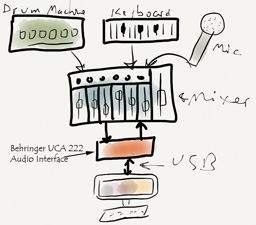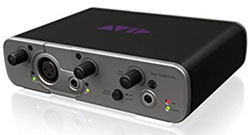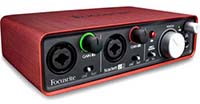This is part 2 of the article – Why You Should Not Use A Mixer In Your Home Recording Studio. In part 1, I spoke of a problem one of our readers was having with his home studio set-up. He routed everything, including the playback, through his mixer, and wondered why he couldn’t do multi-track recording.
 His set-up looked like the picture on the left. I finished part 1 by asking who could see, by the set-up on the left, why the owner of this studio couldn’t seem to get even sequentially-recorded sounds to be by themselves on their own tracks. Here is the problem.
His set-up looked like the picture on the left. I finished part 1 by asking who could see, by the set-up on the left, why the owner of this studio couldn’t seem to get even sequentially-recorded sounds to be by themselves on their own tracks. Here is the problem.
With this set-up, if you record one instrument first, say the drum machine, all will be well. The drum machine goes into the mixer that sends the signal to the UCA222 interface, which sends the signal to the computer and onto a Reaper track. But now you want to record the keyboard part on track 2 in Reaper.
So you arm track 2, disarm track 1, and hit the record button in Reaper. Track 1 is playing back, of course, so you can monitor it and play the keyboard along with it. But you’ve plugged the output of the UCA222 into your mixer, which is blending the drum machine playback with the keyboard you’re recording, and sending both sounds to the main mixer output, which as we know, goes to the inputs of the interface.
And just like that, you’ve recorded BOTH the drums AND the keyboard onto track 2. This is exactly what my reader was complaining about. He wanted ONLY the keyboards on track 2, and the drums on track 1. And yeah, that is how it should be. But you can’t do that with his set-up.
The reader also said he wanted to do simultaneous recording of multiple instruments, and was concerned that Reaper couldn’t do this. First of all, Reaper most definitely CAN do this. But you need an interface capable of receiving multiple inputs, which the UCA222 is not. And once everything is blended (mixed) in the mixer, Reaper certainly cannot separate them again.
He is definitely constrained by his interface to recording only one thing at a time. This is really not a big deal. Lots of folks record this way. But like this reader, there are lots of folks who might expect that they can record multiple instruments/sounds simultaneously (onto their own discrete tracks) just because they have a mixer they can plug everything into. Clearly not so.
One solution might be to NOT plug the USA222’s outputs into the mixer. You could connect your headphones or speakers to the UCA222, making sure to disconnect the interface’s outputs from your mixer. That way you can monitor playback separate from the mixer, and it won’t be fed back into the inputs of the UCA when overdubbing. But then you are still left with the problem of having to use the not-so-great-for-recording mic preamps when you want to record vocals. And if you have speakers plugged into the UCA222’s outputs, you’ll have to disconnect them or turn them off (assuming they have an off switch) when you record the vocals, otherwise the playback of the music will be picked up by the mic. Sigh. These are not terribly difficult work-arounds. But life would be so much easier, and you would have a lot fewer problems if you simply stop using a mixer altogether.

Instead, get yourself a decent recording interface such as an Avid Fast Track, which has a nice-sounding preamp designed for recording. If you need to record more than one sound/instrument simultaneously, get an interface with as many inputs as you need. For example, I use the Focusrite 2i2, which has two mic inputs. Focusrite also makes the Clarett 4Pre and the Clarett 8Pre, with 2, 4 and 8 mic inputs, respectively.

In effect, these interface units are mini-mixers in themselves. You control the input levels of each sound source like you would on a mixer. That, combined with your multi-track recording software’s mixing controls, gives you all the mixing you should need for simple, hassle-free high-quality recording. Forget the mixer. 90 percent of folks don’t need it.
Great article learned a lot.Iam having same problem but I am using a Yamaha USB auido intetface. And I am having same trouble with recording multiple tracks using Sornar X2.would a USB interface mixer have the same trouble.Thank you for you time.
Paul – Thanks! Yes, if your interface only allows a single channel of input, or even a single stereo input, you’re still only going to be able to record one thing/track at a time into a DAW like Sonar. At that point, it doesn’t matter how many “channels” or sliders your mixer has. It will all get combined into a single track’s worth of audio in an interface with only one input into the DAW.
What kind of Yamaha interface do you have?
Ken
Good Article. A slightly contrasting view though; Some of us are enjoy old school mixers, hardware synths, lots of wires and something like a Tascam DP32SD : ) Personally, I think hardware is here to stay. I wish we’d see more hardware digital recorder options in fact. My old Korg D1600 mkii gives me eight line inputs, plus a stereo digital in (making it actually 10 input channels), which I can record all at once to separate channels for post mixing/tweaking. Not mention, I still get a full array of pro quality effects per channel and/or master mix. A more modern unit, like a DP32SD, I get the ease of a SD card to port my work over to my DAW. Personally, unless I have aspirations of super high end demand of the quality, the output from the Korg or the Tascam is more than sufficient for demos or most typical use. Plus, never had a hardware rack or keyboard give me the blue screen of death or lag. ; ) What else is interesting, is I wonder how much value we put on our old analog synths back in the 80’s??? Look at the demand of analog! There’s no doubt that the appreciation of doing things old-school is here for the long haul. Just my humble opinion though….
I don’t disagree, Grumka. In fact I started out this 2-part post saying “If you truly understand all the routing (gozintas and gozouttas, as I’ve heard them described), then using a mixer as part of your home studio CAN be useful.” It’s just that a lot of folks really don’t understand the routing. And they try to use a mixer as an interface for recording, which is not the best choice for most folks (again, it depends on your knowledge level). Getting one or two channels excellent conversion and preamps in a USB audio interface unit is going to be best for most newbies, which is who I gear this site for. But sure. An analog mixer CAN be useful if you know what you’re doing.
Thanks for the comment!
Ken
May I suggest also using the effects sends to send audio signals out without having playback interfere in your signal?
Thanks Chris. Things get really confusing when trying to route stuff out of a DAW by track and channel, and it’s not possible to do that without an interface that allows the multiple outs. Some people can rig up multiple “gozintas and gozouttas” with an analog mixer and a computer. But I still think it’s best for most folks to use a dedicated interface for computer recording.
Cheers!
Ken
Great insight. It is definitely easy to overthink one’s setup especially for beginners. I think one of the fundamental things to learn is the signal chain – when one encounters problems such as too much data entering a single channel, then going back to the signal chain can usually provide good insight into where the problem lies.
Does it only apply to recording? Can it be used for home rehearsal with 2 guitars for sort of a live play through? Does the software have panning feature for each channel?
Absolutely, if your interface has 2 or more input channels. If so, you can put each channel on its own track in your DAW (Reaper in my case) and yes, pan each track independently. But this is MUCH harder to do with a mixer unless you know how to make it output 2 separate channels, which they normally don’t do automatically. Hope that helps.
I have the same system with a Yamaha MG12/4FX mixer. True I can only record one track at a time as the UCA 222 doesn’t allow for multi track use as you explained, however I do record my vocals on a separate track (only vocals on this track) while listening to the audio track from Reaper as follows.
In Reaper there is the audio track (Track 1) and my vocals go on track 2. Track 1 is not armed for recording, track 2 is armed. Mixer channel 1 (my vocals) with mic connected, gain and volume adjusted as required, channel active, headphone output active. The input from the PC comes into a stereo channel on the mixer, that channel is not active (or if active fader fully down), headphone output is active. FX on the mixer active, headphone output active volume slider ∞ (volume off). The output from the mixer to the UCA 222 is from the record BUS on the mixer, (main out fader fully down as the record BUS is a pre fader copy of the main mix), or you can use the main out if you don’t have a record BUS with the faders adjust as required.
Hit record on Reaper and you hear your voice with FX (reverb) and the music in your headphones, but Reaper only records the voice (as that is all that is being sent by the mixer) without music or FX. For this you need to be able to monitor pre fader through the mixer (my mixer does).
The problem is with the quality of the recorded voice. It’s OK and for sure more than good enough for checking how you are doing, making a demo and so on, but not really good enough for “professional” needs, making a CD for example, the limitations of the UCA 222 (and maybe the Yamaha pre amps) don’t provide for best quality recording (but probably your friends and family won’t notice).
Thanks Geoff! You hit on something that is a theme of mine when discussing gear and its use in home recording. It’s basically this: there is a lot to know and so a lot can go wrong. So let your need drive your gear use. Don’t just buy something you don’t have a good reason for. Secondly, I put out a lot of “don’t to this thing” advice. But it is always tempered with a healthy dose of “…unless you know what you’re doing and why you’re doing it.” You clearly understand the way it all works and the limitations. So you know how to avoid the common problems associated with a setup like this.
Thanks for the comment, which may well help someone who wants to try out a similar setup, or is struggling with it!
Cheers!
Hi Ken, great article. I’m thinking in using the PreSonus AudioBox 44vsl Advanced 4×4 USB Midi Recording System to record different tracks a make a final mix in the computer. Would this interface work for this purpose? Also, this interface comes with a recording software but I was thinking in using ProTools, but I’m not sure is they are compatible, do you know? (presonus interface and protools software)
Hi John. Yes it will work for the purpose you describe. It’s designed to accept 4 inputs and is described by Presonus as “great for small bands” because of that. As for whether it will work with Pro Tools, it should, as long as you are using version 9 or above. But I can’t say for sure. they don’t officially support interface units that are not Avid. So you’d have to check the Pro Tools site – https://www.avid.com/pro-tools/ – and maybe check there. But it should work.
Hi there Ken, thanks for this advice, its something I was immediately aware of the first time I looked at the routing for my desk!
Would one other solution be to route the interface back to a separate group on the mixer which is only switched on for playback purposes?
Well sorta. I don’t think you need to create any groups. The output of an interface unit is designed such that the USB port is the primary route for recording, and then accepting a playback signal from the computer as well. That prevents a lot of confusion for routing if you ALSO have a mixer. But for monitoring the playback through speakers, there is also a pair of 1/4-inch plug outputs in interface units that you can just either plug into two mono channels of your mixer or a stereo channel of your mixer. It is really just that easy.
I run a similar setup. never had that problem. All dude needed to do was mute the drum machine input to avoid the overlap. Before I got into multi-track sequence recording I did everything real time one instrument at a time. when an instrument or track is recorded. ..mute the input immediately afterwards.
You can record a single track at a time just by using the UCA222. It has a monitor switch. You can hear any recorded tracks you already have and just record the new one. I tested it after reading this article and thinking “nah, this little interface won’t be able to do it if a big mixer can’t”. But it does. I have a small mixer on order and I would cancel the order were it not for a couple of other features it offers. After reading your article I understand a bit more about mixers. This particular one on order has FX sends but they are post fader so you can’t do the same one track at a time thing with it, already recorded tracks wil go to the main mix. Thinking of changing my order to something with both pre/post aux outputs or a pre/post switch. First world problems… Again, thanks for your writeup and replies to comments. Cheers!
Thanks for the comment. The bottom line is that there are interfaces specifically designed to record audio into a computer. And they are straight-forward/easy to understand. I saw folks using standard mixers NOT designed to connect to a computer trying to record into one. And though it isn’t impossible to make that happen, it’s incredibly involved and just not what the mixer was designed to do. Now I realize that lately there are hybrid mixers that ARE capable of connecting to a computer, and that’s different. Plus if you knew what you were doing, you could make anything work. But a LOT of folks didn’t really know, and were getting frustrated because they had the wrong tool for the job. It sounds like you know what you’re doing. Thanks again for the comment!